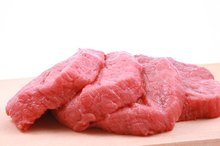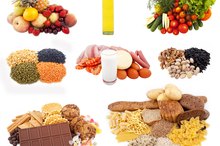Why Are Proteins Used As the Last Source of Energy?
Proteins are an important part of your diet and provide 4 calories per gram of protein, which means they can be used as a source of energy. When you consume proteins, your body breaks down the protein into its component amino acids, which can then be burned for energy. There are two different ways in which amino acids can be used as an energy source, but there are distinct drawbacks to these metabolic pathways.
Amino Acid Breakdown
One way in which amino acids can be used as an energy source is by converting them into other compounds that can be used in energy-generating chemical reactions. Some amino acids, known as glucogenic amino acids, can be turned into glucose. Glucogenic amino acids include alanine, serine, glycine and valine. Others, known as ketogenic amino acids, cannot be turned into glucose but can be broken down for use in separate chemical pathways.
- One way in which amino acids can be used as an energy source is by converting them into other compounds that can be used in energy-generating chemical reactions.
- Others, known as ketogenic amino acids, cannot be turned into glucose but can be broken down for use in separate chemical pathways.
Chemical Reactions That Use Amino Acids
Carbohydrates & Respiration
Learn More
Both methods of using amino acids for fuel involve a series of chemical reactions known as the Krebs cycle, a series of chemical reactions your body uses to generate energy. When blood glucose levels get very low, the body can use amino acids to make more glucose. This is necessary because some cells, such as neurons and red blood cells, can use only glucose for fuel. The glucogenic amino acids can be converted into large molecules that contain four or five carbon atoms that, when used as a substrate for the Krebs cycle, can be converted into glucose. Ketogenic amino acids form smaller molecules that, though unable to be turned into glucose, can still be used in the Krebs cycle for energy.
- Both methods of using amino acids for fuel involve a series of chemical reactions known as the Krebs cycle, a series of chemical reactions your body uses to generate energy.
- Ketogenic amino acids form smaller molecules that, though unable to be turned into glucose, can still be used in the Krebs cycle for energy.
Disadvantages of Amino Acid Catabolism
Amino acid catabolism is the process of using amino acids as an energy source. Turning amino acids into molecules that can be used in the Krebs cycle takes energy, which means that burning protein for fuel is not as efficient as burning carbohydrates. In addition, your body needs amino acids to make new proteins. When amino acids are used as an energy source, it reduces the reserves of amino acids that are available for protein synthesis.
- Amino acid catabolism is the process of using amino acids as an energy source.
- Turning amino acids into molecules that can be used in the Krebs cycle takes energy, which means that burning protein for fuel is not as efficient as burning carbohydrates.
Amino Acids and Ammonia
ATP & Protein
Learn More
Another disadvantage of using protein as an energy source is the byproducts of amino acid catabolism. All amino acids contain nitrogen atoms. When these amino acids are broken down, the nitrogen is converted into ammonia. Ammonia can be toxic when it accumulates in your blood, so your body has to excrete the ammonia through your urine. Although your kidneys can excrete moderate amounts of ammonia, if you break down too many amino acids, the increased ammonia excretion can stress your kidneys.
- Another disadvantage of using protein as an energy source is the byproducts of amino acid catabolism.
- Ammonia can be toxic when it accumulates in your blood, so your body has to excrete the ammonia through your urine.
Related Articles
References
- BioCarta: Glucogenic and Ketogenic Amino Acids
- Elmhurst College Virtual Chembook: Protein Metabolism
- Hoffman JR, Falvo MJ. Protein - which is best?. J Sports Sci Med. 2004;3(3):118-30.
- Tessari P, Lante A, Mosca G. Essential amino acids: Master regulators of nutrition and environmental footprint?. Sci Rep. 2016;6:26074. doi:10.1038/srep26074
- Marsh KA, Munn EA, Baines SK. Protein and vegetarian diets. Med J Aust. 2013;199(4 Suppl):S7-S10.
- Gropper SS, Smith JL, Groff JL. Advanced Nutrition and Human Metabolism. Sixth Edition. Wadsworth Publishing Company, 2013.
- Smolin LA, Grosvenor, MB. Nutrition: Science and Applications. Third Edition. Wiley Publishing Company, 2013.
Writer Bio
Adam Cloe has been published in various scientific journals, including the "Journal of Biochemistry." He is currently a pathology resident at the University of Chicago. Cloe holds a Bachelor of Arts in biochemistry from Boston University, a M.D. from the University of Chicago and a Ph.D. in pathology from the University of Chicago.









